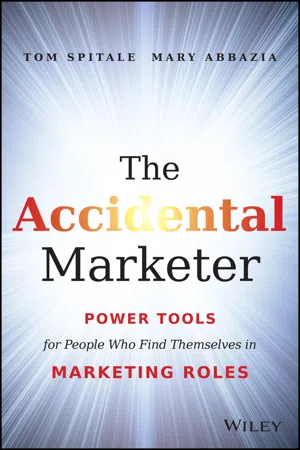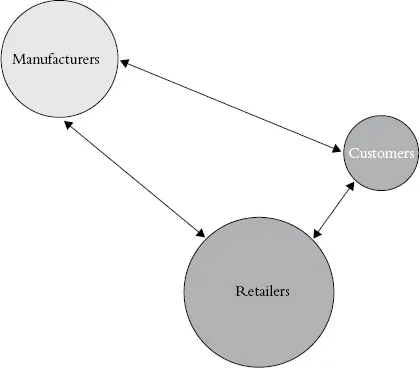
eBook - ePub
The Accidental Marketer
Power Tools for People Who Find Themselves in Marketing Roles
This is a test
- English
- ePUB (mobile friendly)
- Available on iOS & Android
eBook - ePub
The Accidental Marketer
Power Tools for People Who Find Themselves in Marketing Roles
Book details
Book preview
Table of contents
Citations
About This Book
A practical guide for inexperienced marketers who have to develop a marketing strategy
With technology being built into products of all kinds, many businesses are hiring scientists, engineers, and designers to fulfill strategic marketing and product management roles. The Accidental Marketer is a practical guide for employees who are now responsible for developing strategy. These marketers will be able to immediately and successfully apply the ten tools featured in the book to create powerful strategies that increase sales and profits for any product in any industry.
- Explains how great marketers uncover insights about customers that competitors miss and use new insights to create a range of strategic options for their marketing plans
- Shows how the best marketers execute their strategies through developing innovative branding and communication plans and value propositions
The Accidental Marketer allows any inexperienced marketer to step into a new role and develop an effective strategy.
Frequently asked questions
At the moment all of our mobile-responsive ePub books are available to download via the app. Most of our PDFs are also available to download and we're working on making the final remaining ones downloadable now. Learn more here.
Both plans give you full access to the library and all of Perlego’s features. The only differences are the price and subscription period: With the annual plan you’ll save around 30% compared to 12 months on the monthly plan.
We are an online textbook subscription service, where you can get access to an entire online library for less than the price of a single book per month. With over 1 million books across 1000+ topics, we’ve got you covered! Learn more here.
Look out for the read-aloud symbol on your next book to see if you can listen to it. The read-aloud tool reads text aloud for you, highlighting the text as it is being read. You can pause it, speed it up and slow it down. Learn more here.
Yes, you can access The Accidental Marketer by Tom Spitale, Mary Abbazia in PDF and/or ePUB format, as well as other popular books in Business & Marketing. We have over one million books available in our catalogue for you to explore.
Chapter 1
Who Moved My . . . Customer?
The Simple Concept behind Dell’s Success in the PC Market
Power Tool: Influencer Map
I don’t skate to where the puck is; I skate to where the puck is going to be.—Wayne Gretzky, aka “The Great One,” one of the greatest hockey players of all time
A Tool to Detect Shifts in Decision-Making Power before Your Competitors Do
“Are you sure you want to start the book with a story about Dell?” one of our advisors asked with a raised eyebrow. A very successful business author himself, our coach was voicing a legitimate concern about the overexposed nature of some case histories, especially stories about companies whose star has somewhat faded.
But we convinced him that the Dell story is a great way to start off the book. And we’ll use the same argument to persuade you to pay close attention to this chapter.
With regard to the faded star nature of Dell’s current business, wouldn’t any business like to have a 20-year run like Dell did from 1984 to 2004, when the company grew from a founder’s dorm room to the number one position in the massive personal computers industry? Any lessons gleaned from Dell’s meteoric rise are worth learning if they can deliver even a fraction of this kind of growth.
Although many business professionals, including Accidental Marketers, have heard Dell’s story, only a few have made any significant changes to their own business strategy based on it. We can confidently say, after conducting hundreds of workshops, that virtually every client we work with improves their strategy based on the Dell case as we present it.
We know this because we translate Dell’s strategies (and a few other mini-cases in the chapter) into a tool—one that helps you immediately apply Dell’s lessons in your industry. We’ll provide important, interesting background facts about Dell’s marketing approach, but the tool—called an Influencer Map—will allow you to make a key decision that will drive the rest of your customer-focused marketing strategy.
Influencer Maps show Accidental Marketers how to detect shifts in customer and stakeholder decision-making power in a market before their competitors do. Of the 10 tools that make up our base set, Influencer Maps are one of the most popular with our clients. Once you see how simple yet powerful they can be, you will share their enthusiasm!
The Roots of an Industry Revolution
At the very beginnings of the personal computer era back in 1984, Michael Dell realized he had some seemingly unrelated skills. He’d already had several successful direct mail ventures in junior high school and high school. Selling stamps and trading cards had netted him $2,000 in profits at the ripe old age of 12. A few years later, he utilized a mailing list of newly married couples to sell newspaper subscriptions. He made enough money to buy himself a BMW while still in high school.
As a freshman at the University of Texas, Dell had figured out how to take apart and put back together an IBM personal computer (PC). He started a successful computer upgrade business that he ran out of his dorm room, which allowed him to deeply understand the economics of computer selling.
The combination of Michael Dell’s computer prowess and direct mail experiences was about to create an opportunity that would revolutionize the industry. And the simple concept behind that opportunity hadn’t even occurred to the big PC manufacturers of the time.
The Big Guys Get Blinded by the Customer Status Quo
As Michael Dell contemplated a new type of PC business, strategic planners for the leading manufacturers of the time, such as IBM, Compaq, and Tandy, were likely preoccupied with product-oriented issues. Because computer use grew by more than 750 percent from 1980 to 1985, merely being able to predict and supply this exploding demand was a constant, focus-sapping concern for the market leaders.
Another element that distracted PC strategists was the implications of Moore’s Law. This amazingly accurate theory, postulated by Gordon Moore, the founder of computer chip giant, Intel, predicted that computing power would double every 18 months. This geometric progression of chip technology led to a dizzying pace of new PC features and functions, which all competitors were struggling to keep up with.
At least one element of the industry that seemed stable was the method for distributing and selling PCs. Computers reached consumers via distributors, value-added resellers and retailer networks that each big manufacturer had painstakingly built. The process worked this way because computers were considered a highly technical item requiring expert hand-holding and assistance during the decision-making process.
A simple diagram shows how the era’s leading manufacturers likely viewed decision-making power in the PC market at the time. Each circle in Figure 1.1 represents a stakeholder. The size of the circle indicates decision-making power, with the arrows indicating how each stakeholder influences the others in the chain.

Figure 1.1 Decision-Making Power in the 1980s Personal Computer Market: Likely View of the Leading Manufacturers
Source: Copyright © 2014 Impact Planning Group. All rights reserved.
Although Figure 1.1 may have been technically correct, it doesn’t account for how the decision-making power of each of these stakeholders was changing in a very dynamic market. Judging by their actions, Dell’s competitors likely assumed that the power structure in the market would remain relatively consistent. In fact, they acted as if they believed that only computer nerds and scientists would be comfortable making decisions about which PC to buy without expert assistance. This would prove to be a dangerous—and eventually fatal—competitive assumption that Dell Inc. took full advantage of.
You Can Assess Changing Influence Now—or Risk Losing to a Competitor Who Does
It’s at precisely this time in a market—things are going well, sales are growing, the industry is in an early life cycle phase—when companies tend to focus extremely closely on product. Even suggesting that a company reassess its customer/stakeholder chain is often considered a throwaway strategic step. Organizations see this as a box to be checked on the way to out-product-featuring the competition, focusing solely on its traditional customers.
But time and again, we find companies that are doing one of two very different things: they’re either capitalizing on stakeholder power shifts or finding themselves locked out of strong relationships with customer groups that faster-thinking competitors already own. Some examples of the latter are:
- The marketers of a former blockbuster drug, now off-patent, who put all of their resources toward selling to general practitioners and specialists—and now find themselves late to the game in figuring out how to ensure pharmacists don’t switch customers to a generic version of the drug
- The makers of baby formulas in emerging markets who don’t have any relationships with their country’s governmental policy-makers—until the government pulls the product from all retail shelves based on a perceived health issue that turns out to be unwarranted
- The manufacturers of a technically superior hip implant who have forgotten to call on managers of a key administrative hospital function—the operating room scheduler, who then promoted a competitor’s inferior product because they didn’t understand the more advanced device’s benefits and because they thought the implanting operation took too long
On the positive side, we see companies achieving tremendous growth by anticipating stakeholder shifts. Network management software company SolarWinds has developed a product positioned as a low-priced solution sold directly to information technology (IT) managers rather than chief information officers (CIOs).
SolarWinds correctly anticipated a corporate trend that is pushing certain IT decisions downward in organizations. The industry moved from an environment in which CIOs made virtually all software decisions to one in whi...
Table of contents
- Cover
- Contents
- Title
- Copyright
- Dedication
- Preface
- Acknowledgments
- Chapter 1: Who Moved My . . . Customer?
- Chapter 2: The Fountain from Which Great Marketing Flows
- Chapter 3: Are You Making Lukewarm Tea?
- Chapter 4: What Business Are You Really In?
- Chapter 5: Who Do You Love?
- Chapter 6: What Were They Smoking?
- Chapter 7: The Magnetic Effect of Focus
- Chapter 8: Viva la Differentiation
- Chapter 9: A Positioning Statement Is a Terrible Thing to Waste
- Chapter 10: Reinventing a Commodity
- Closing Remarks
- Resources
- Index
- End User License Agreement